
|   |

|   |
The 28th OMC Guru Kelucharan Mohapatra Award Festival - Tapati Chowdhurie e-mail: tapatichow@yahoo.co.in Photos courtesy: Srjan October 13, 2022 The 28th OMC Guru Kelucharan Mohapatra Award Festival 2022 (Sept 5 - 9) started with a Hindustani instrumental jugalbandi dedicating it to Kathak maestro Pt Birju Maharaj and Odissi samrat Guru Kelucharan Mohapatra. Srjan paid homage to the departed souls of the two greats. The bond between Pt Birju Maharaj and Guru Kelucharan Mohapatra was fondly reminisced by Guru Ratikant Mohapatra. Srjan, as a premier cultural institution of the nation, recognizes its role in sustaining creative energy and artistic endeavour, while fulfilling its social responsibility to the public and the Art fraternity. After two years of successfully hosting the Guru Kelucharan Mohapatra (GKCM) Award Festival on digital platforms, they brought the Award Festival back to the proscenium stage at Rabindra Mandap in Bhubaneswar. After the welcome address by Ratikant Mohapatra, Director, Srjan, the first evening's program featured flautist Ronu Majumdar, Taufiq Qureshi and Ishaan Ghosh. 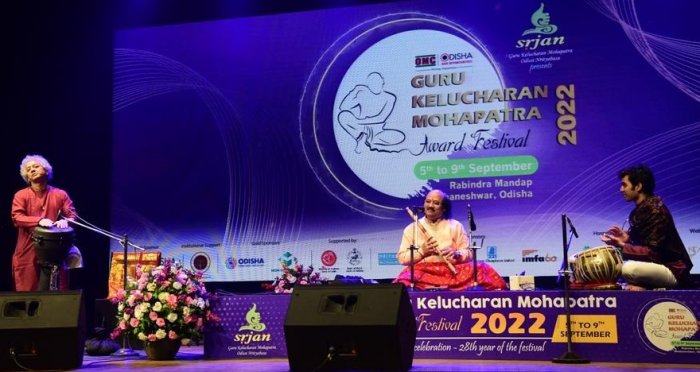 Taufiq Qureshi, Ronu Majumdar and Ishaan Ghosh Firmly rooted in the Maihar gharana, Pt Majumdar is constantly expanding the boundaries of his music oeuvre and has conducted 'Venu Naad,' a concert of 5,378 flautists on one stage for the Guinness World Records. Ace percussionist Taufiq Qureshi, the son and disciple of tabla maestro Ustad Allarakha, known for his distinct technique of playing the African drums instrument djembe, gave a power filled performance. The young and exceptionally talented Ishaan Ghosh delivered a memorable performance on the tabla, with his rare articulations and complex rhythmic tapestries with appealing delineations materializing the vision of his father Pt Nayan Ghosh. The cadence and harmony of their notes mesmerized the audience, as they presented 'Synthesis: A Classical Medley,' beginning with raga Jai Jaiwanti. This track was followed by a confluence of ragas and talas. The evening concluded on a high note, with the evocative playing of the flute, and the rhythmic intricacies of the djembe and tabla, as the artistes delved into their musical repertoires. The sweet sound of Majumdar's flute music endeared his audience to him. Taufiq Qureshi known for creating motifs spanning across cultures has discovered a new language to the tabla syllables in djembe. His music was so infectious that the audience incessantly clapped at almost all that he played. 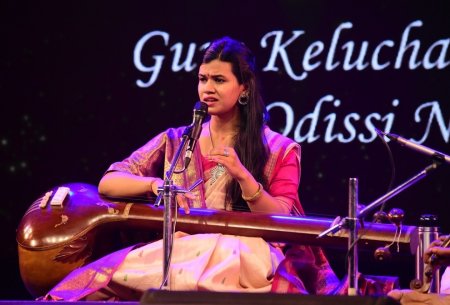 Sristi Swarupa Mishra The program had been designed with an eye on the most suitable combination of artistes of both music and dance genres. The second evening of the festival opened with an Odissi vocal recital by Sristi Swarupa Mishra, accompanied by Guru Dhaneswar Swain on the mardala and Guru Ramesh Chandra Das on the violin. She opened with Saraswati Vandana in raag Saraswati, completing her recital with Chatur Taal Prabandha in four taals. Her melodious singing assured that Odissi music was in safe hands. 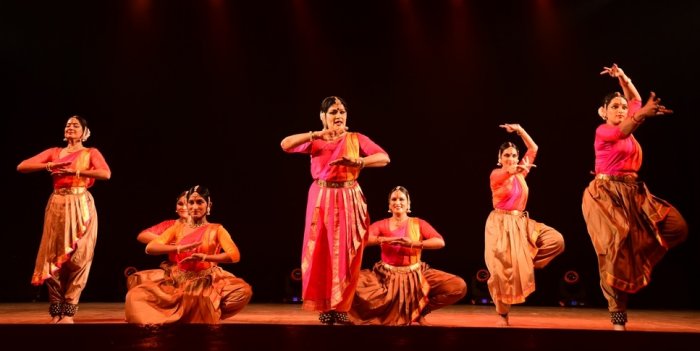 Geeta Chandran and Natya Vriksha ensemble This was followed by a Bharatanatyam group performance by Geeta Chandran and her Natya Vriksha Dance Collective. Geeta Chandran and her group's presentation of Alarippu was in the most innovative way possible. Rather than presenting the rhythm based piece which focuses on relaxing the body and mind, she innovated on the diverse culture of the country. Built on the foundation of tisram Alarippu, Jay Bharat was a take on 'unity in diversity'. It was well integrated and re-imagined reflecting the concepts of multiple cultures of our country. It was a rhythmic marvel though served on a different platter. Sakhi Swaram was built on the foundation of Jathiswaram, where Geeta Chandran explored with her group an empowered vision on Bharatanatyam. The pure nritta piece Jatiswaram in which one finds adavus or dance movements strung together in abstract nritta phrases and sentences called korvais, that are filled into repetitive raga cadence, with the crisp geometric grammar of Bharatanatyam in Geeta's hand was seen as a group of young girls growing up together. Their games, wiles and secrets were woven together and built in the strict jathis of the master choreographer K.N.Dandayudhapani Pillai, to the mridangam beats of Lalgudi Shri Ganesh, singing of K. Venkateswaran, violin of C.S. Anurup while nattuvangam was by Geeta herself. The abhinaya piece showcasing vatsalya rasa in "Krishna nee begane baro" was performed solo by Geeta. The piece was taught to her by Swarna Saraswathi, on which Geeta has perfected the art of displaying a mother's love for her child, who is none other than the blue eyed god Krishna. The finale of the group was Kalidasa's Ritu Samhara. Geeta successfully explored the impact of the seasons on the human mind with the music of Tchaikovsky. Her attempt to present pure Bharatanatyam with the background music of Tchaikovsky to express human activities and the role of the seasons was to imbue a global feeling. 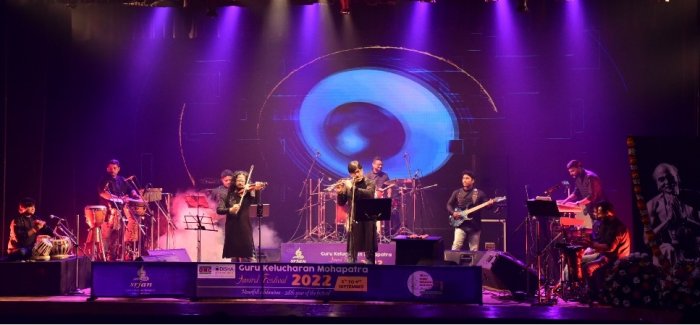 Shivagni ensemble The musical presentation of Shivagni ensemble on the third day of the festival was close to the heart of the audience. Each and every piece was welcomed with joy. The spirit of music mesmerized the singers and listeners equally. The ensemble is the most happening thing in Odisha. They commenced their scintillating recital with a piece on Ganesh, and with the inspiration from the audience who actively participated in their rendition of numbers 'Impassioned', 'Odissi fusion', 'Boond', 'Oasis', 'Kabira', 'Touch of Heaven', 'Raagmala' starting with Bhupali, Bagesri, Natbhairav, Shyam Kalyan, Vasant, and Jog, they set the stage on fire with the mesmerized audience cheering them at every bend and corner. The piece 'Shivansh' in which they used the popular shloka 'Jatabi Gallajjala' to build a rich tapestry, concluded their recital. Odissi fusion music included "Brajo Rajo kumoro", "Sangini re, rasho rangini re", "Dekho go Radha Madhava chali" and punched in Shankarabaranam Pallavi to add to the flavour in Odissi fusion music. Musical Melange by Shivagni Ensemble featured violinist Agnimitra Behera, keyboard player Ramesh Chandra Behera, tabalia Biswa Ranjan Nanda, drummer Bikasit Sahu, lead guitarist Deba Ranjan Nayak, flautist Srinibas Satpathy, percussionist Baibhav Kumar Das, bass guitarist Pranav Pradhan and vocalist Milan Kumar Panda. 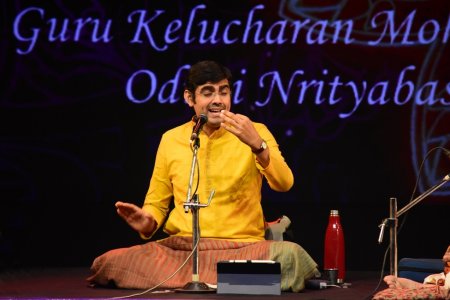 Sikkil Gurucharan On day four, Carnatic vocalist Sikkil Gurucharan accompanied by V. Sanjeev on the violin and N.C. Bharadwaj on the mridangam delighted the aficionados of music. In his own words the maestro of Carnatic music said that since he was singing on Guruvar/Thursday, his first song was going to be on Shiva and he commenced with "Guru Brahma Guru Vishnu...." paying his obeisance to Guru before breaking into a song on Shiva. 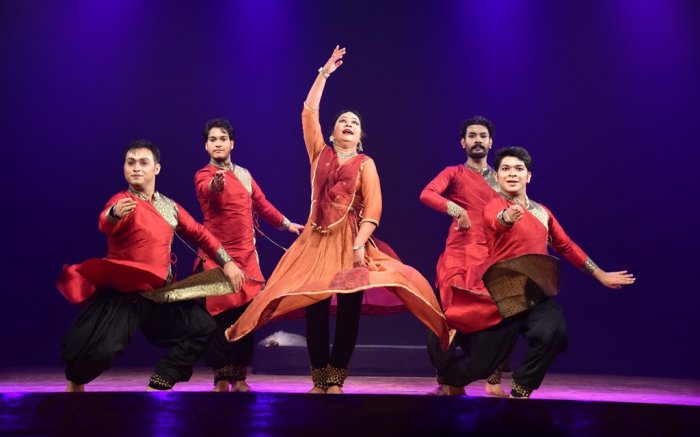 Paramita Maitra and dancers of Nrityangan Kathak Kendra Since the festival was dedicated to the memory of Pt Birju Maharaj, it was most appropriate that one of his talented disciples should be present to showcase his style of Kathak. Paramita Maitra is known for adapting tradition to modern sensibilities. With many innovative choreographic works to her credit she took the stage with "Mrityunjay", a maha mantra which allows one to attain 'anga suddhi', 'chitta suddhi' and 'atma suddhi'. Through flawless Kathak she addressed Lord Shiva and conveyed the message that one's soul can be liberated through the worshipping of Trayambaka or Rudra Shiva. Debasish Sarkar spelt magic through his vocal rendition of "Shivo Shivo namo Shivo"- a verse from the Rig Veda . He was accompanied on the tabla by Biswajeet Pal and on the sitar by Chandrachud Bhattacharya. Having achieved complete rapport with the audience, she embarked upon Taal Dhamar of 14 beat metre after invoking the blessings of Devi through the chant of "Sarva mangala mangalye Shive sarvartha sadhike sharanye trayambake Gowri Narayani namastute." The display of the technicalities of Kathak with power and vibrancy brought home the beauty of the form. The performers of Nrityangan Kathak Kendra danced with spirit and power. "Uthaye ja unke sitam" a ghazal that was rendered soon after was poetic and drowning the audience in a world of love and beauty, the music resonated for a long time. 'Vadya Chitra' was a piece where the percussion instruments were personified. Pakhawaj, khol and ghungroo along with tabla and dhol were given roles to play. Vadya Chitra suggested a picture drawn by the musical drum with the ghungroo as the painting brush. Pakhawaj was a metaphor representing veera rasa displayed through tandava - rendered in Chautaal of 12 beats. The melody of khol was a metaphor for sringar rasa rendered in soft lasya style. Tabla represented prakriti and purush. Finally Ulhas was rendered through beats on the dhol suggesting outpourings of joy and happiness. The climax was reached when ghungroo dances ecstatically with the drums. The piece was very innovative. The stage was a riot of colours with the energetic dancers creating magic through their flawless dance. The rasikas were truly awestruck. 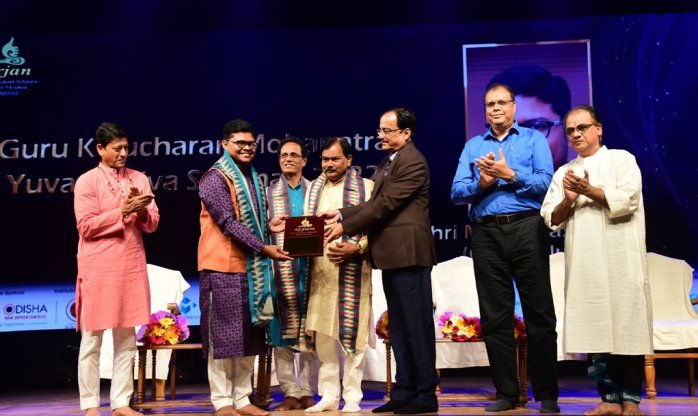 The awardees On the closing day, Guru Kelucharan Mohapatra Award 2022 for dance and music were awarded to Guru Niranjan Rout and Guru Ramhari Das respectively (with 1 lakh each and a citation), while Geetanjali Acharya and Matruprasad Das were awarded the Guru Kelucharan Mohapatra Yuva Prativa Samman (with Rs.25,000 and a citation). 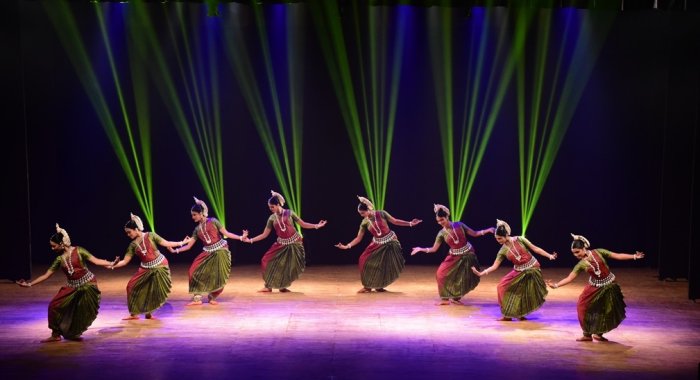 Srjan ensemble The award ceremony was followed with Srjan ensemble's Odissi presentation of 'Ravan.' The 'Khal nayak' becomes the 'nayak'. Ravana, a man of true qualities - the ruler of Lanka, scholar, musician and above all a devotee of Shiva- vilified in the great epic Ramayana, has a tragic fall. Watching the piece crafted in a deft way by Ratikant Mohapatra reminded me of the Bengali writer Michael Madhusudan Dutt's 'Meghnad Badh' kavya. Meghnad, the son of Ravana in Dutt's epic poem is the protagonist. And he was killed by Lakshman, when the former was unarmed. Both Ravan and Meghnad, fell on account of circumstances or karma - give it any name. Many are there who sympathise with these fallen heroes. In his own inimitable style the sutradhara of Ratikant's dance drama was his very well trained group. That really made a difference in making his drama visually rich. The story was taken forward by the group dancers who narrated through dance vocabulary what was to follow. It was a very imaginative way of telling the story. Solo characters of Brahma and Mandodari were enacted by Sipra Swain and Aishwariya Singh Deo, who are accomplished dancers. In Ratikant Mohapatra's drama, Ravana is a winner, because his aspiration to die at the hands of Rama to gain moksha was fulfilled. Ratikant Mohapatra in the role of Ravan was excellent, his expressional dance spoke volumes. Rajashri Praharaj as Sita was an epitome of a young maiden fearful of Ravan's machinations. Ravan is a well crafted piece, where Ravan meets his end in the hands of Rama, who along with his brother Lakshmana, has broken many rules of warfare. But as the adage goes, all is fair in love and war. The artistes were aided by the skilful and distinctive light designing of Debiprasad Mishra and the seamless sound engineering of C. Anand Krishna. 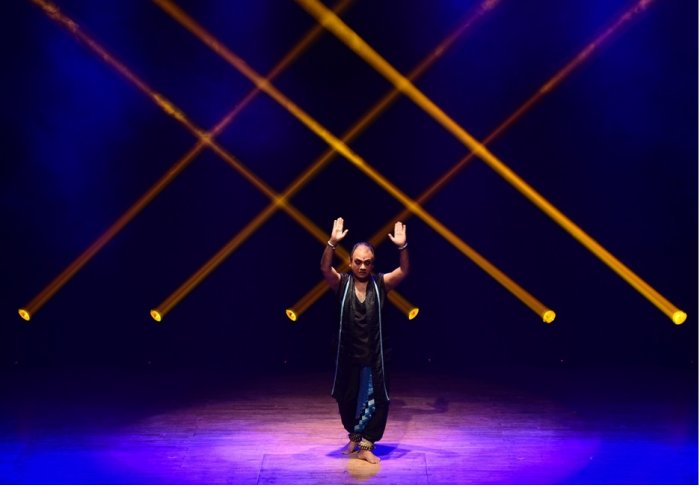 Ratikant Mohapatra The entire festival had been curated, conceptualized, and designed by Guru Ratikant Mohapatra, while the program execution was by Debiprasad Mishra. Mrutyunjaya Rath and Anuja Mishra ably conducted the proceedings of the evening. This year, Srjan is fortunate to receive the institutional support of Sri Sri University, Cuttack, a leading educational institution of India. The title sponsor of the festival was Odisha Mining Corporation Limited (OMC). The 28th OMC GKCM Award Festival is supported by the Ministry of Culture, Government of India, and the Department of Odia Literature Language and Culture, Government of Odisha, among others.  Tapati Chowdhurie trained under Guru Gopinath in Madras and was briefly with International Centre for Kathakali in New Delhi. Presently, she is a freelance writer on the performing arts. |